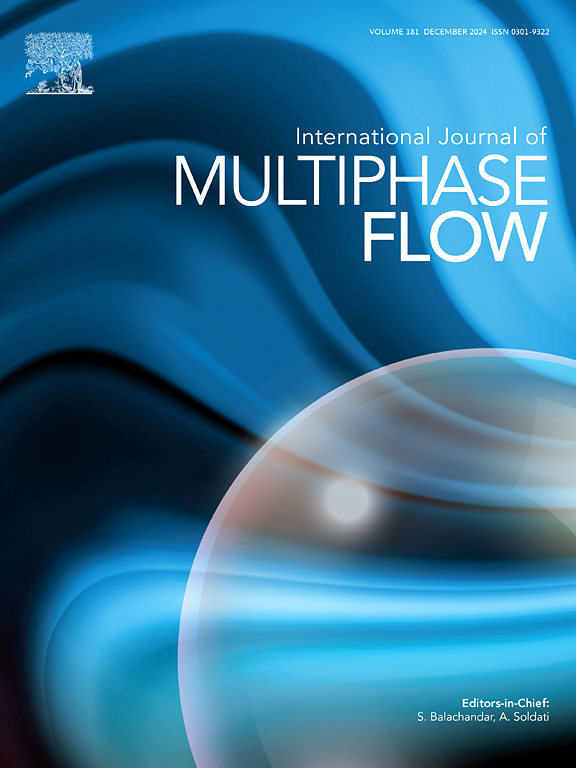垂直过冷流沸腾冷凝气泡人工智能辅助热水力分析方法的发展
IF 3.6
2区 工程技术
Q1 MECHANICS
International Journal of Multiphase Flow
Pub Date : 2025-04-12
DOI:10.1016/j.ijmultiphaseflow.2025.105246
引用次数: 0
摘要
过冷流沸腾在核反应堆和热管理系统等各种工业应用中至关重要。冷凝气泡从产生到破裂的快速而复杂的动力学对传统的气泡检测方法提出了重大挑战。鉴于此,开发并验证了一种最先进的人工智能方法,用于检测和跟踪过冷流动沸腾中的冷凝气泡,从而能够有效地执行热工分析。本研究初步采用计算机视觉技术高效构建气泡数据集。然后在该数据集上训练一个气泡检测模型,该模型利用带有注意机制的YOLOv8。在气泡检测成功后,多目标跟踪算法跨连续帧跟踪气泡。开发的基于人工智能的方法已被证明是非常有效的,可以检测95%的冷凝气泡,并简化了关键热工参数的提取,包括长径比、Sauter平均直径、空隙分数、界面面积浓度、离开直径、生长时间、气泡寿命、努塞尔数和成核位置密度。通过与经验关联的比较,验证了该模型的准确性和一致性,验证了该模型在分析过冷流动沸腾复杂动力学过程中的可靠性。此外,它还提供了详细的热工水力参数波动数据。这种基于人工智能的方法不仅提高了监测和分析过冷流沸腾的可靠性和效率,而且体现了人工智能在精炼复杂工业过程中的变革潜力。本文章由计算机程序翻译,如有差异,请以英文原文为准。

Development of the AI-assisted thermal hydraulic analysis method for condensing bubbles in vertical subcooled flow boiling
Subcooled flow boiling is critical in various industrial applications such as nuclear reactors and thermal management systems. The rapid and complex dynamics of condensing bubbles, from their inception to collapse, pose significant challenges for conventional bubble detection methods. In light of this, a state-of-the-art AI method is developed and validated for the detection and tracking of condensing bubbles in subcooled flow boiling, thereby enabling the effective execution of thermal hydraulic analyses. This study initially employs computer vision technology to efficiently construct a bubble dataset. A bubble detection model, utilizing YOLOv8 with an attention mechanism, is then trained on this dataset. Following successful bubble detection, a multi-object tracking algorithm tracks the bubbles across successive frames. The developed AI-based method has proven highly effective, detecting 95 % of condensation bubbles and streamlining the extraction of key thermal hydraulic parameters, including aspect ratio, Sauter mean diameter, void fraction, interfacial area concentration, departure diameter, growth time, bubble lifetime, Nusselt number, and nucleation site density. The model's accuracy and consistency are demonstrated compared to empirical correlations, affirming its reliability in analyzing the intricate dynamics of subcooled flow boiling. Additionally, it provides detailed fluctuation data on thermal hydraulic parameters. This AI-based method not only improves the reliability and efficiency of monitoring and analyzing subcooled flow boiling but also exemplifies the transformative potential of AI in refining complex industrial processes.
求助全文
通过发布文献求助,成功后即可免费获取论文全文。
去求助
来源期刊
CiteScore
7.30
自引率
10.50%
发文量
244
审稿时长
4 months
期刊介绍:
The International Journal of Multiphase Flow publishes analytical, numerical and experimental articles of lasting interest. The scope of the journal includes all aspects of mass, momentum and energy exchange phenomena among different phases such as occur in disperse flows, gas–liquid and liquid–liquid flows, flows in porous media, boiling, granular flows and others.
The journal publishes full papers, brief communications and conference announcements.

 求助内容:
求助内容: 应助结果提醒方式:
应助结果提醒方式:


